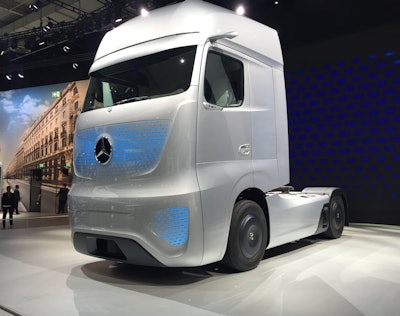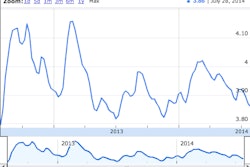Editor’s note: This story was originally published Aug. 1.
 Daimler unveiled this concept truck, the Future Truck 2025, last month. Click here or the photo to read more on it.
Daimler unveiled this concept truck, the Future Truck 2025, last month. Click here or the photo to read more on it.
In a perfect world, fleet managers and owner-operators would be breathlessly awaiting all the stunning technological vehicle innovations coming their way – hopping up and down in anticipation with arms flung wide to welcome this bold new world and all the promises and benefits it holds for them.
We all know this isn’t the case.
There is a lot of angst out there about the massive Technology Wave bearing down on the trucking industry. Americans in general don’t like change. Truckers in particular don’t like change.
And although our society has seen a massive amount of technological change in the past 20 years (Exhibit A: The smartphone that is most assuredly on your body or within easy reach right now), most of this change has been administered in measured, easy-to-digest doses: First you got a cell phone and learned how to use it. And that worked out pretty well. Then smartphones came out, and they weren’t so different.
Then you learned about “apps” and started using them. Then they came out with tablets – which were a little like your smartphone, but also a little like a laptop… And so on. The point is most of us eased into a lot of the new technology we use every day now. So, by and large, it wasn’t a bad experience and the learning curve was manageable.
With trucks, however, there is a very palpable feeling in the industry that technology is rapidly outpacing the learning curve. Taking things a step further, a lot of seriously old-school guys are wondering just what the point of all this technology actually is.
Are engineers just designing these systems because they can? Are there any real benefits to all this stuff? And if there are benefits, are they worth the unsettling price increases that go along with this new technology? And by the way, who is going to work on all this science fiction technology when it does break down and get the truck back out on the road in a timely (and affordable) manner?
That’s why some serious people in the industry think we may see a whole new commercial vehicle market emerge here in North America. For lack of a better term, it’s being called the “disposable” truck concept.
I mentioned the concept of a disposable truck in passing in a blog post earlier this year. And when I got back into the office the next week, my Hard Working Trucks colleague Jason Cannon had posted a news story about a brand-new truck company out of Yakima, Washington.
The new medium-duty truck builder (note that I am not calling it a “manufacturer”) is called Rainer Truck & Chassis Company. It was founded by a guy named Gary Jones to fill a niche created by fleet owners who don’t want a lot of technology in a truck.
Jones’ philosophy can be summed up in an exchange he had with Jason, who interviewed him about his new company. On a modern truck, Jones noted, if the dome light in the cab goes out, a fault code is generated and the driver gets a message telling him the dome light is out and needs to be replaced. On Rainier cabovers, Jones says, if the dome light goes out, the driver can look up, see the dome light is out and tell somebody it needs to be replaced.
Jones is exaggerating, but only slightly. And he’s got a point that resonates with many in this industry: Having computer-generated messages for endless items on a truck adds multiple layers of complexity and cost to the vehicle. Jones is offering a new, fully emissions-compliant medium-duty truck that is simple, straight-forward and tough. And he’s banking there are enough medium fleets out there that will find this concept appealing to sell his products to.
This is a scenario that was correctly predicted by Frost & Sullivan analyst Sandeep Kar at CCJ’s Commercial Vehicle Outlook Conference several years ago. Karr argued that as the complexity – and price – of new vehicles continued to rise, the free market would rush to exploit niches created by fleets who don’t want, or need, rolling computer systems.
Taking it further, Kar tied the desire to lower-cost, low-tech trucks to the wave of globalization we find ourselves in today. The North American and European truck markets are dominated by OEMs offering increasingly sophisticated vehicles. But manufacturers elsewhere in the world are building tough, durable, low-tech trucks designed to work – and survive – in places like Russia, India and Africa. And they’d love to sell trucks – or at least various vehicle components and systems – to American manufacturers and builders.
Need a medium-duty cab? There are plenty of European builders who’d be happy to sell you one that meets all U.S. crash and safety criteria.
Need a tough, reliable diesel engine? Cummins will be happy to sell you as many as you want.
You’ve got to have a transmission. How about an Allison automatic? ZF also has several models to pick and choose from. Or perhaps an Aisin unit out of Japan?
Need a frame and a chassis? No problem. Lots of suppliers have plenty on hand. Meritor would be delighted to provide you with axles. Bendix would be more than happy to spec you a braking system.
This is exactly the approach Jones is taking with Rainier: His cabs are imported. He’s got Cummins power. It’s a simple, scalable design that takes advantage of components already commonly found on medium-duty trucks in service in North America today.
Kar threw the term “disposable truck” out as he described these vehicles. Jones calls his truck a “K.I.S.S” concept – as in Keep It Simple, Stupid. But the basic idea is the same: A more affordable, yet tough truck that you can run until the wheels fall off and then go buy another one.
Jones is the first to try this concept here in the U.S. But it’s likely others will follow in his footsteps. In some ways, this is a natural, free-market evolution brought about by both the major OEMs’ push to add technology to their trucks, but also the hand-in-hand efforts to enhance vertical integration throughout their product lines.
The OEM argument says that as complexity and technology on trucks increase, it is vital that their components are spec’d exclusively on the vehicle to ensure compatibility and maximum efficiency. But if you’re a Cummins, Meritor, Bendix or Wabco, it’s only natural that you’d like to offset any losses to the Big Boys due to vertical integration by supplying quality components to companies like Rainier.
We’re about to see how popular the low-cost/low-tech truck concept actually is as Jones gets Rainier up and running and begins to offer trucks for sale. His target market for these trucks is the Class 4-7 cabover market – which makes sense on multiple levels.
Could the same concept work in the Class 8 market? My sense is that it could definitely find a niche in some vocational, P&D and regional applications. But the need for driver retention and the growing acceptance of telematics (and, yes, technology in general) will limit its attractiveness to line haul fleets and sleeper/reefer fleets.
But who’s to say? If the low-tech truck concept is a hit, it’s very likely the major OEMs will counter with their own stripped down and affordable trucks for certain applications. That’s the way the free market works.
So if you’re one of the many truckers out there fretting about the effects of technology on trucks today, don’t fret. As Sandeep Kar predicted, and Gary Jones is demonstrating, the last chapter on the truck of the future is far from written.










